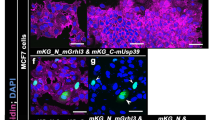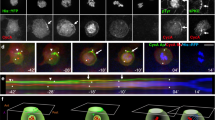Abstract
Polarized cells contain numerous membrane domains, but it is unclear how the formation of these domains is coordinated to create a single integrated cell architecture. Genetic screens of Drosophila melanogaster embryos have identified three complexes, each containing one of the PDZ domain proteins — Stardust (Sdt), Bazooka (Baz) and Scribble (Scrib) — that control epithelial polarity and formation of zonula adherens. We find that these complexes can be ordered into a single regulatory hierarchy that is initiated by cell adhesion-dependent recruitment of the Baz complex to the zonula adherens. The Scrib complex represses apical identity along basolateral surfaces by antagonizing Baz-initiated apical polarity. The Sdt-containing Crb complex is recruited apically by the Baz complex to counter antagonistic Scrib activity. Thus, a finely tuned balance between Scrib and Crb complex activity sets the limits of the apical and basolateral membrane domains and positions cell junctions. Our data suggest a model in which the maturation of epithelial cell polarity is driven by integration of the sequential activities of PDZ-based protein complexes.
This is a preview of subscription content, access via your institution
Access options
Subscribe to this journal
Receive 12 print issues and online access
$209.00 per year
only $17.42 per issue
Buy this article
- Purchase on Springer Link
- Instant access to full article PDF
Prices may be subject to local taxes which are calculated during checkout





Similar content being viewed by others
References
Tepass, U., Theres, C. & Knust, E. crumbs encodes an EGF-like protein expressed on apical membranes of Drosophila epithelial cells and required for organization of epithelia. Cell 61, 787–799 (1990).
Hong, Y., Stronach, B., Perrimon, N., Jan, L. Y. & Jan, Y. N. Drosophila Stardust interacts with Crumbs to control polarity of epithelia but not neuroblasts. Nature 414, 634–638 (2001).
Bachmann, A., Schneider, M., Theilenberg, E., Grawe, F. & Knust, E. Drosophila Stardust is a partner of Crumbs in the control of epithelial cell polarity. Nature 414, 638–643 (2001).
Tepass, U. & Knust, E. Crumbs and stardust act in a genetic pathway that controls the organization of epithelia in Drosophila melanogaster. Dev. Biol. 159, 311–326 (1993).
Wodarz, A., Hinz, U., Engelbert, M. & Knust, E. Expression of crumbs confers apical character on plasma membrane domains of ectodermal epithelia of Drosophila. Cell 82, 67–76 (1995).
Wodarz, A., Ramrath, A., Grimm, A. & Knust, E. Drosophila atypical protein kinase C associates with Bazooka and controls polarity of epithelia and neuroblasts. J. Cell Biol. 150, 1361–1374 (2000).
Petronczki, M. & Knoblich, J. DmPAR-6 directs epithelial polarity and assymetric cell divsion of neuroblasts in Drosophila. Nature Cell Biol. 3, 43–49 (2001).
Kuchinke, U., Grawe, F. & Knust, E. Control of spindle orientation in Drosophila by the Par-3-related PDZ-domain protein Bazooka. Curr. Biol. 8, 1357–1365 (1998).
Muller, H. A. & Wieschaus, E. armadillo, bazooka, and stardust are critical for early stages in formation of the zonula adherens and maintenance of the polarized blastoderm epithelium in Drosophila. J. Cell Biol. 134, 149–163 (1996).
Bilder, D. & Perrimon, N. Localization of apical epithelial determinants by the basolateral PDZ protein Scribble. Nature 403, 676–680 (2000).
Bilder, D., Li, M. & Perrimon, N. Cooperative regulation of cell polarity and growth by Drosophila tumor suppressors. Science 289, 113–116 (2000).
Woods, D. F. & Bryant, P. J. The discs-large tumor suppressor gene of Drosophila encodes a guanylate kinase homolog localized at septate junctions. Cell 66, 451–464 (1991).
Jacob, L., Opper, M., Metzroth, B., Phannavong, B. & Mechler, B. M. Structure of the l(2)gl gene of Drosophila and delimitation of its tumor suppressor domain. Cell 50, 215–225 (1987).
Mathew, D. et al. Recruitment of Scribble to the Synaptic Scaffolding Complex Requires GUK-holder, a Novel DLG Binding Protein. Curr. Biol. 12, 531–539 (2002).
Tepass, U. Crumbs, a component of the apical membrane, is required for zonula adherens formation in primary epithelia of Drosophila. Dev. Biol. 177, 217–225 (1996).
Grawe, F., Wodarz, A., Lee, B., Knust, E. & Skaer, H. The Drosophila genes crumbs and stardust are involved in the biogenesis of adherens junctions. Development 122, 951–959 (1996).
Drubin, D. G. & Nelson, W. J. Origins of cell polarity. Cell 84, 335–344 (1996).
Cox, R. T., Kirkpatrick, C. & Peifer, M. Armadillo is required for adherens junction assembly, cell polarity, and morphogenesis during Drosophila embryogenesis. J. Cell Biol. 134, 133–148 (1996).
Wieschaus, E. & Noell . The speicificity of embryonic lethal mutations in Drosophila analysed in germ-line clones. Roux Arch. Dev. Biol. 195, 63–73 (1986).
Bilder, D. PDZ proteins and polarity: functions from the fly. Trends Genet. 17, 511–519 (2001).
Tepass, U., Tanentzapf, G., Ward, R. & Fehon, R. Epithelial cell polarity and cell junctions in Drosophila. Annu. Rev. Genet. 35, 747–784 (2001).
Lin, D. et al. A mammalian PAR-3–PAR-6 complex implicated in Cdc42/Rac1 and aPKC signalling and cell polarity. Nature Cell Biol. 2, 540–547 (2000).
Joberty, G., Petersen, C., Gao, L. & Macara, I. G. The cell-polarity protein Par6 links Par3 and atypical protein kinase C to Cdc42. Nature Cell Biol. 2, 531–539 (2000).
Qiu, R. G., Abo, A. & Martin, G. S. A human homologue of the C. elegans polarity determinant Par-6 links Rac and Cdc42 to PKCz signaling and cell transformation. Curr. Biol. 10, 697–707 (2000).
Legouis, R. et al. LET-413 is a basolateral protein required for the assembly of adherens junctions in Caenorhabditis elegans. Nature Cell Biol. 2, 415–422 (2000).
McMahon, L., Legouis, R., Vonesch, J. L. & Labouesse, M. Assembly of C. elegans apical junctions involves positioning and compaction by LET-413 and protein aggregation by the MAGUK protein DLG- 1. J. Cell Sci. 114, 2265–2277 (2001).
Bossinger, O., Klebes, A., Segbert, C., Theres, C. & Knust, E. Zonula adherens formation in Caenorhabditis elegans requires dlg-1, the homologue of the Drosophila gene discs large. Dev. Biol. 230, 29–42. (2001).
Borg, J. P. et al. ERBIN: a basolateral PDZ protein that interacts with the mammalian ERBB2/HER2 receptor. Nature Cell Biol. 2, 407–414 (2000).
Lee, S. S., Weiss, R. S. & Javier, R. T. Binding of human virus oncoproteins to hDlg/SAP97, a mammalian homolog of the Drosophila discs large tumor suppressor protein. Proc. Natl Acad. Sci. USA 94, 6670–6675 (1997).
Nakagawa, S. & Huibregtse, J. M. Human scribble (Vartul) is targeted for ubiquitin-mediated degradation by the high-risk papillomavirus E6 proteins and the E6AP ubiquitin-protein ligase. Mol. Cell. Biol. 20, 8244–8253 (2000).
den Hollander, A. I. et al. Mutations in a human homologue of Drosophila crumbs cause retinitis pigmentosa (RP12). Nature Genet. 23, 217–221 (1999).
White, K. et al. Genetic control of programmed cell death in Drosophila. Science 264, 677–683 (1994).
Schober, M., Schaefer, M. & Knoblich, J. A. Bazooka recruits Inscuteable to orient asymmetric cell divisions in Drosophila neuroblasts. Nature 402, 548–551 (1999).
Miller, K. G., Field, C. M. & Alberts, B. M. Actin-binding proteins from Drosophila embryos: a complex network of interacting proteins detected by F-actin affinity chromatography. J. Cell Biol. 109, 2963–2975 (1989).
McDonald, K. M., Sharp, D. J. & Rickoll, W. in Drosophila Protocols (eds Sullivan, W., Ashburner, M. & Hawley, R. S.) 245–273 (Cold Spring Harbor Laboratory Press, New York, 2000).
Acknowledgements
We thank A. Wodarz, A. Muller and M. Peifer for providing reagents, C. Villalta for technical assistance, and B. Mathey-Prevot and reviewers for comments on the manuscript. We also thank G. Tanentzapf and U. Tepass for sharing data before publication. N.P. is an Investigator of the Howard Hughes Medical Institute. M.S. acknowledges support from Boehringer Ingelheim Fonds. D. B. acknowledges support from the American Cancer Society, the Leukemia Society of America, and the Burroughs-Wellcome Fund.
Author information
Authors and Affiliations
Corresponding author
Ethics declarations
Competing interests
The authors declare no competing financial interests.
Supplementary information
Supplementary Figure
Figure S1. scrib and dlg enhance crb gain-of-function phenotypes. (PDF 270 kb)
Rights and permissions
About this article
Cite this article
Bilder, D., Schober, M. & Perrimon, N. Integrated activity of PDZ protein complexes regulates epithelial polarity. Nat Cell Biol 5, 53–58 (2003). https://doi.org/10.1038/ncb897
Received:
Revised:
Accepted:
Published:
Issue Date:
DOI: https://doi.org/10.1038/ncb897
This article is cited by
-
The SF3B1R625H mutation promotes prolactinoma tumor progression through aberrant splicing of DLG1
Journal of Experimental & Clinical Cancer Research (2022)
-
PI3Kδ activity controls plasticity and discriminates between EMT and stemness based on distinct TGFβ signaling
Communications Biology (2022)
-
Apical–basal polarity and the control of epithelial form and function
Nature Reviews Molecular Cell Biology (2022)
-
Characterization of the cell polarity gene crumbs during the early development and maintenance of the squid–vibrio light organ symbiosis
Development Genes and Evolution (2017)
-
The PCP pathway regulates Baz planar distribution in epithelial cells
Scientific Reports (2016)



